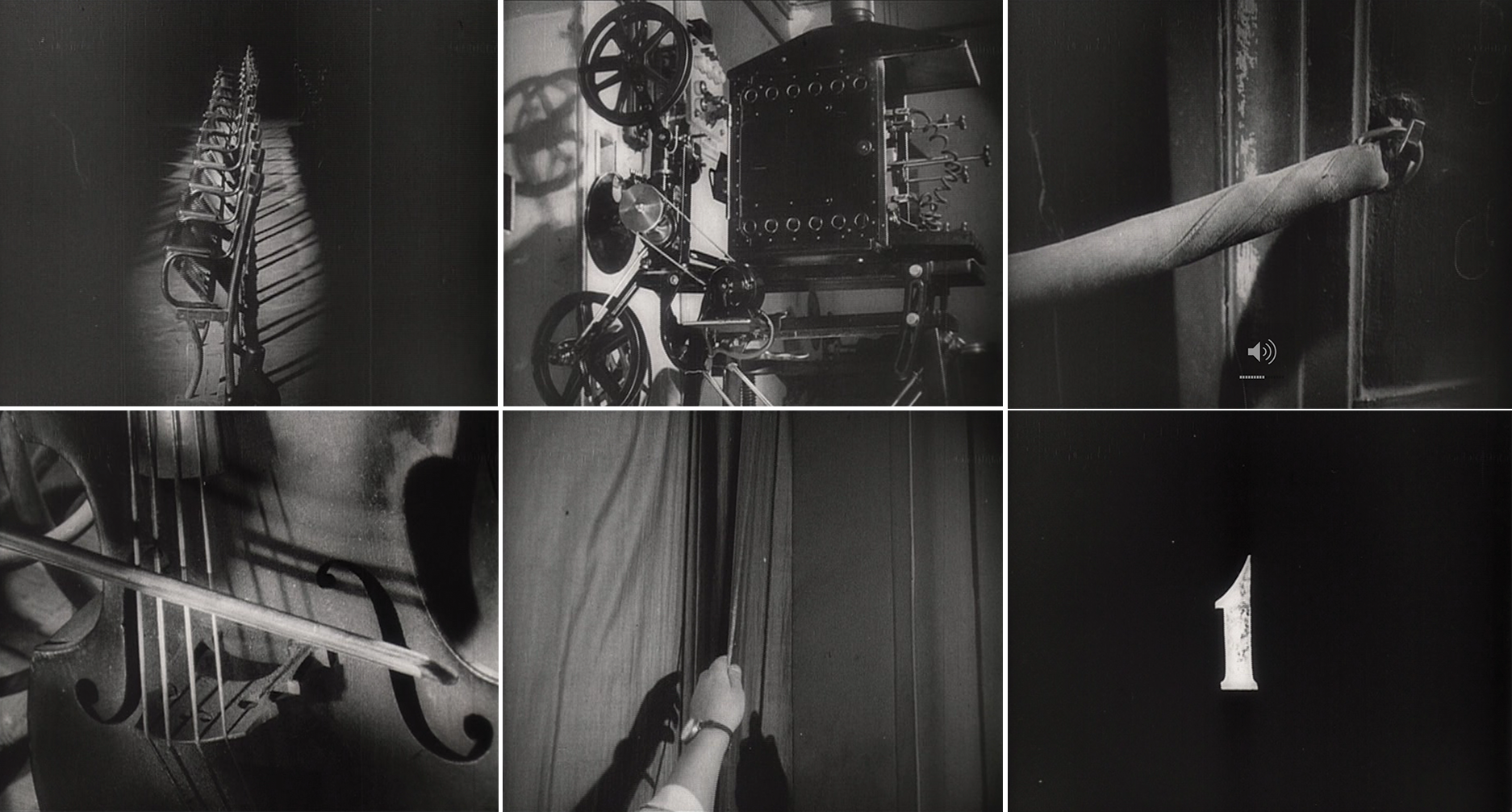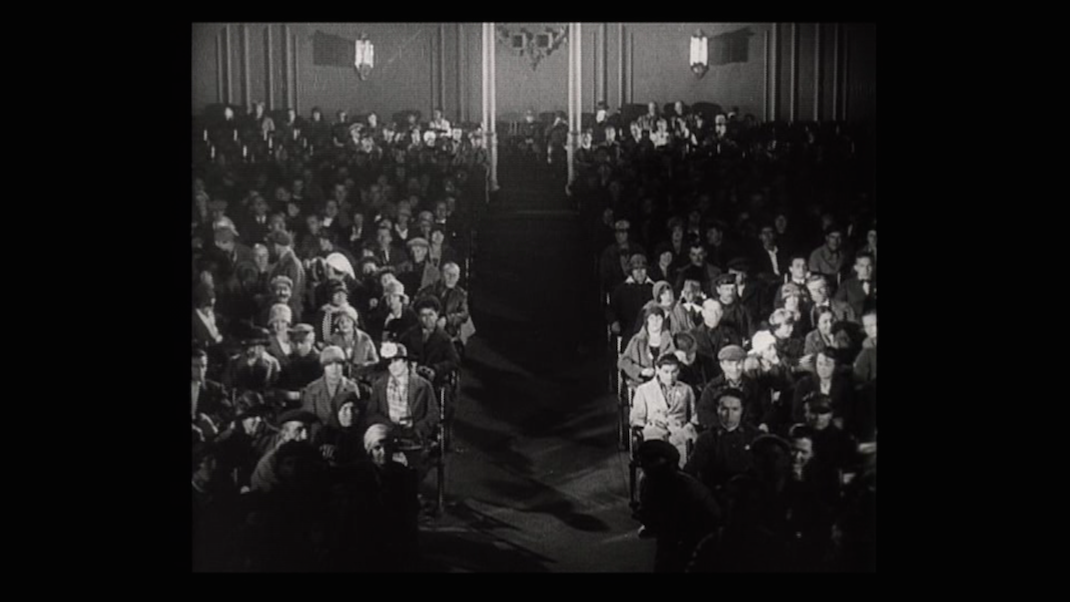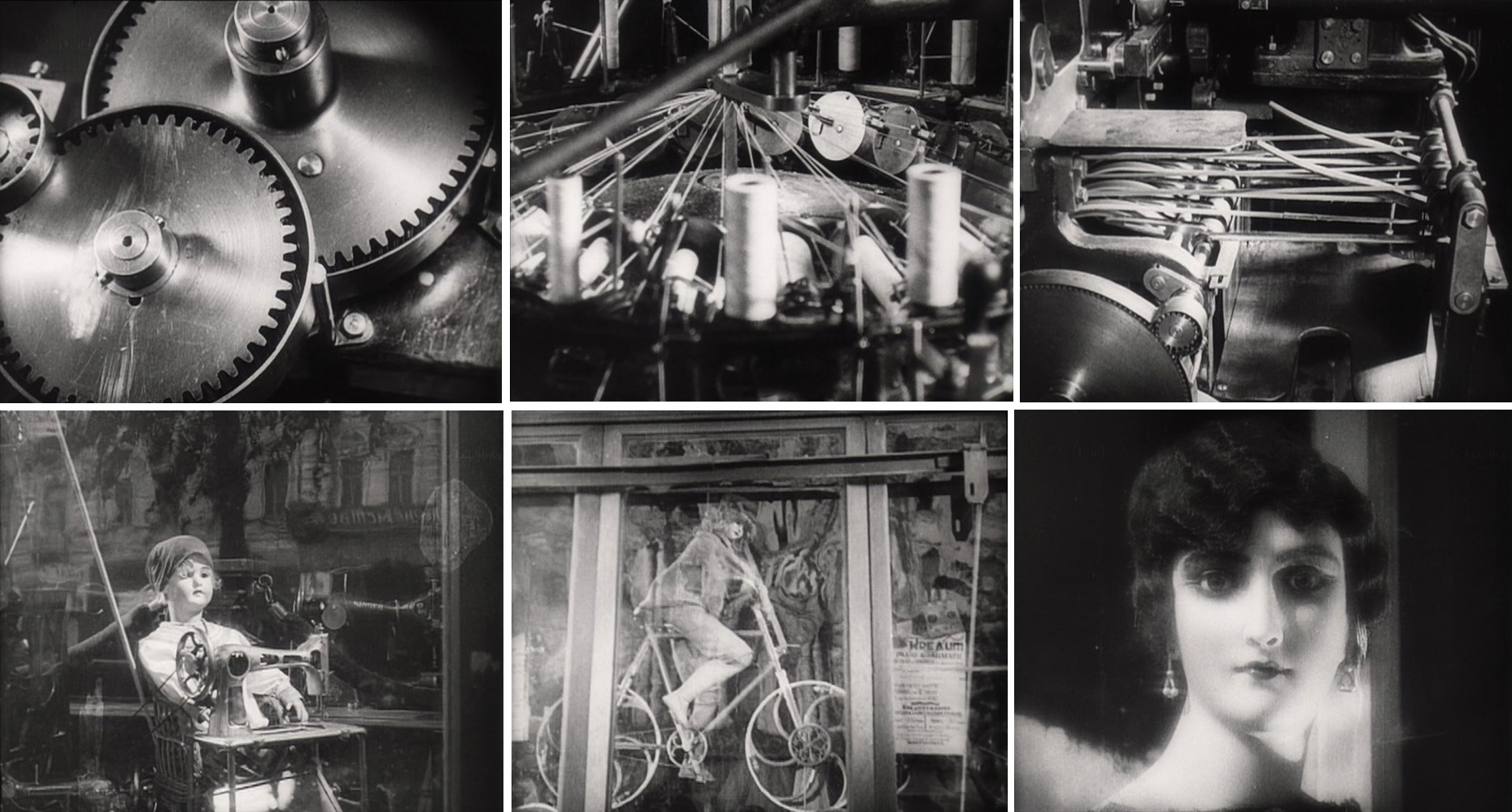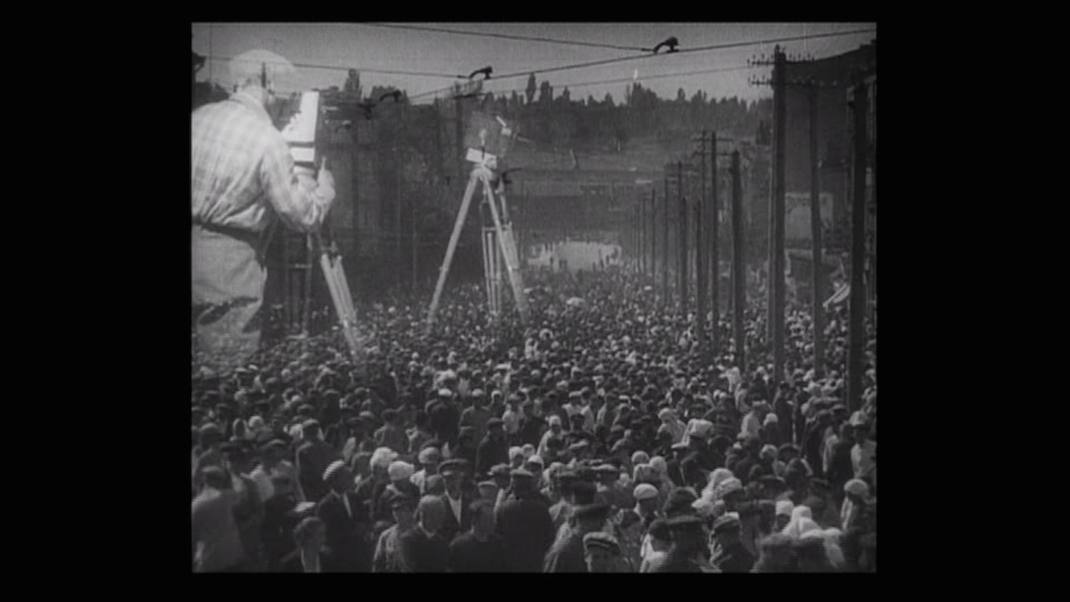In “Independent Study in World Cinema,” a self-educated film nerd attempts to fill in some fairly serious gaps in his self-education. In this sixth entry in the series, we look at Russian filmmaker Dziga Vertov's experimental 1929 documentary Man with a Movie Camera.
As I recently explained, I had two good reasons for abandoning my Independent Study three years ago: the large amount of work involved in writing these posts, and the relatively small number of people who seemed (at the time) to be interested in reading them. But there was actually a third factor in my decision to quit that I didn't mention.
You see, I had hit the point in my syllabus where I was supposed to discuss Dziga Vertov's Man with a Movie Camera.
And I really, really didn't want to.
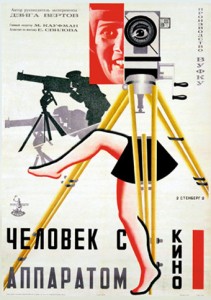 To be fair, I'd had no idea what I was signing up for when I originally added Man with a Movie Camera to my self-imposed syllabus. One of the inspirations for this entire series—and a reference guide in making my selections—was Sight and Sound magazine's decennial list of the greatest films of all time. In August of 2012, the magazine announced the results of this decade's poll of critics and directors, and among old standbys like Citizen Kane, Vertigo, and Rules of the Game, there suddenly appeared on the critic's Top 10 list this 1929 film called Man with a Movie Camera (Человек с киноаппаратом), directed by Dziga Vertov.
To be fair, I'd had no idea what I was signing up for when I originally added Man with a Movie Camera to my self-imposed syllabus. One of the inspirations for this entire series—and a reference guide in making my selections—was Sight and Sound magazine's decennial list of the greatest films of all time. In August of 2012, the magazine announced the results of this decade's poll of critics and directors, and among old standbys like Citizen Kane, Vertigo, and Rules of the Game, there suddenly appeared on the critic's Top 10 list this 1929 film called Man with a Movie Camera (Человек с киноаппаратом), directed by Dziga Vertov.
I confess, I had never heard of Vertov or this movie, but its reputation among critics had evidently been growing. It had been #44 in the 1992 poll, and #27 in 2002, but in 2012 it suddenly jumped in at #8. (In fact, it knocked our old friend Battleship Potemkin off the Top 10 list for the first time since the poll began in 1952.) Intrigued, I dutifully ordered the DVD and slotted Man with a Movie Camera into my schedule.
And then, in February of 2013—fresh off the high of The Passion of Joan of Arc—I watched it. And I really didn't like it at all. Only 67 minutes in length, it felt endless: it was literally all I could do to keep my ass in the chair for the first viewing, and I certainly had no desire to watch it again, or to spend a lot of time thinking about it. (It is my custom to watch each film at least three times when I'm writing these posts: once just to experience it openly, a second time to take notes on my own observations, and at least once more to reexamine it after I've read the thoughts of other critics and commenters. But I couldn't imagine doing that with Man with a Movie Camera, and I had absolutely no desire to write about it.)
I could have just dropped it from the schedule, of course, but that seemed like cheating. I could have just forced myself to do it, but that sounded like Hell. So, instead—as is my nature—I shamelessly procrastinated. Days turned to weeks, and weeks turned to months, and eventually I just let myself off the hook with the justification that no one was particularly clamoring for the next post in this series anyway. Do svidaniya, Man with a Movie Camera!
This year, when I decided to resurrect this series, I knew Man with a Movie Camera would still be sitting there, staring at me accusingly like a judgmental Soviet elephant in the room. And, let's face it, it probably wouldn't be the last film on my list that didn't immediately transport me into the throes of cinematic ecstasy. Was I really committed to learning about the important works in film history, and why other people hold them in such high regard? Or was I just a lazy dilettante open only to the sorts of movies I already liked?
Though everything in me was arguing for "lazy dilettante," I ultimately decided to be diligent and give Man with a Movie Camera another shot. I can't pretend I went into it this time with a completely open mind, but I did the best I could.
And at this point—since I haven't done this in a while–I feel obligated to remind you that I do not claim any expertise about these films, and I do not for a moment pretend I can acquire expertise in a few viewings over a couple of weeks. These posts are not meant to be authoritative: far from it. They are, in fact, an attempt to share my fumbling, ill-informed, not particularly coherent thoughts, arising from my brief experience with the movie, bolstered by some very random and haphazard poking around on the web. There are no doubt obvious aspects I have not considered, brilliant and cogent analyses I have not encountered, and universally acknowledged facts that I've just plain gotten wrong.
With that (no-doubt inspiring) disclaimer, let us begin…
Background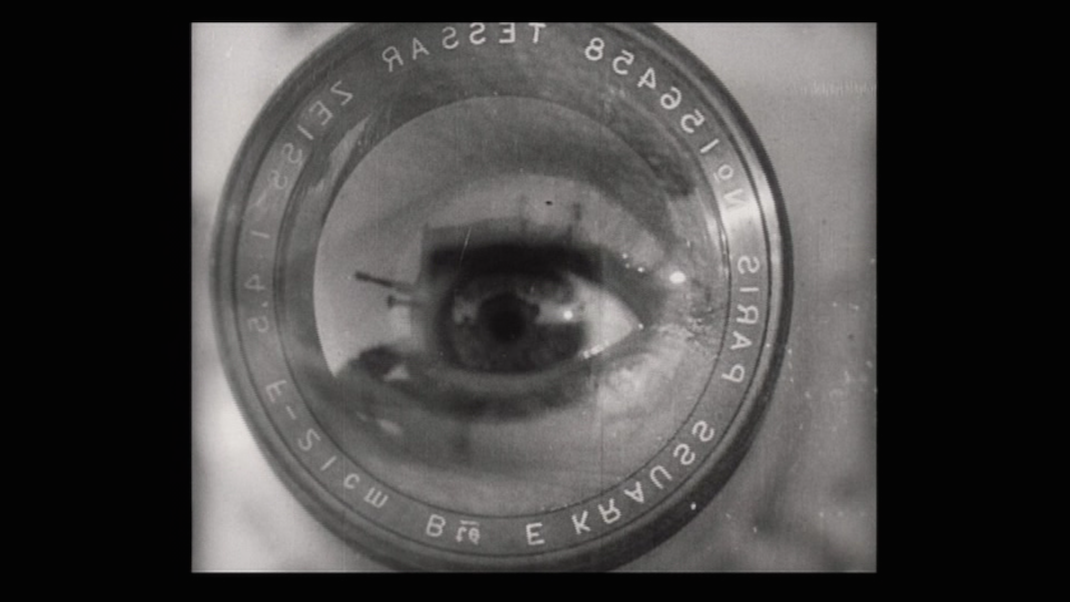
To understand this film—and my own resistance to it—we should begin our discussion with a rallying cry, a statement of principles, a declaration of war:
WE proclaim the old films, based on the romance, theatrical films and the like, to be leprous.
—Keep away from them!
—Keep your eyes off them!
—They’re mortally dangerous!
—Contagious!
WE affirm the future of cinema art by denying its present.
“Cinematography” must die so that the art of cinema may live. WE call for its death to be hastened.
Those are the words of Dziga Vertov, from "WE: Variant of a Manifesto," published in the Soviet film journal Kinofot in 1922. The best background I could possibly provide for Man with a Movie Camera would be to reproduce, in its entirety, Dziga Vertov's provocative, rambling, audacious manifesto. In it, we are provided a comprehensive template for what Vertov was trying to accomplish as a filmmaker:
WE are cleansing kinochestvo [a neologism of Vertov's invention, meaning roughly "the quality of the cinema-eye"] of music, literature, and theater; we seek our own rhythm, one lifted from nowhere else, and we find it in the movement of things.
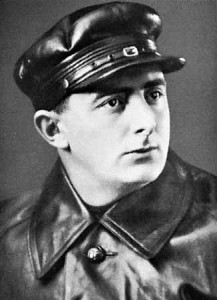 Just as importantly, I think, we get from this manifesto a good sense of what an incredibly arrogant, smug, self-important, pretentious little dweeb Vertov himself must have been.
Just as importantly, I think, we get from this manifesto a good sense of what an incredibly arrogant, smug, self-important, pretentious little dweeb Vertov himself must have been.
Born David Abelevich Kaufman in 1896, Vertov grew up in Bialystok, the son of a bookseller and the grandson of a Rabbi. (His family fled to Russia during the First World War.) He studied music in his youth, and his earliest artistic obsessions were aural, not visual: in his early twenties he produced "sound poems," experimenting with complex audio montages and verbal representations of audible sounds. But his frustrations with the available technology for capturing the full range of aural experience led him to film. As he wrote:
Once in the spring of 1918… returning from a train station there lingered in my ears the signs and rumble of the departing train … someone swearing … a kiss … someone’s exclamation … laughter, a whistle, voices, the ringing of the station’s bell, the puffing of the locomotive … whispers, cries, farewells … And I thought to myself whilst walking: I must get a piece of equipment that won’t describe but will record, photograph these sounds. Otherwise it’s impossible to organize, to edit them. They rush past, like time. The movie camera perhaps? Record the visible … Organize not the audible, but the visible world. Perhaps that’s the way out?1
By 1918 Kaufman had taken the pseudonym "Dziga Vertov"—which roughly translates from the Ukrainian as "Spinning Top"—and begun working in newsreel production. He rose up through the ranks of the Soviet documentary system, working on one of the "agitprop" trains, and editing documentary newsreel footage for the Moscow Film Committee. Soon, Vertov and his friends were given responsibility for launching a regular Soviet newsreel called Kino-Pravda, on which they developed and refined their experimental montage techniques and their theories about film. Vertov and his film-obsessed cronies—including his future wife/editor Elisabeta Svilova and his brother/cinematographer Mikhail Kaufman—made a number of feature-length, increasingly experimental documentaries, and became known as the Kino-Oki (Cinema-Eyes), or "kinoks."
It was in the name of this group that the 1922 "manifesto" was issued. I'm not going to pretend I can do justice to their beliefs and theories here, but essentially the kinoks thought mainstream cinema was hopelessly and dangerously bourgeois. They denounced artifice, rejected narrative, and dismissed movies that were simply staged literature or theater as another opiate of the masses. This new medium required an entire new vocabulary and syntax, they believed, and the cinema of the future would be a cinema of truth, uniquely positioned to capture "fragments of actuality" and the chaotic reality of "life caught unawares."
For this purpose, Vertov believed, the camera's eye was vastly superior to the human eye. And, in fact, machines were rather superior to human beings in general. As he writes in the Manifesto:
The 'psychological' prevents man from being as precise as a stopwatch; it interferes with his desire for kinship with the machine.
In the art of movement we have no reason to devote out particular attention to contemporary man.
The machine makes us ashamed of man's inability to control himself, but what are we to do if electricity's unerring ways are more exciting to us than the disorderly haste of active men and the corrupting inertia of passive ones?
Saws dancing at a sawmill convey to us a joy more intimate and intelligible than that on human dance floors.
For his inability to control his movements, WE temporarily exclude man as a subject for film.
In much of this, we can see an evolution from Eisenstein's theories to something more extreme. Where Eisenstein drastically simplified his story in Battleship Potemkin, Vertov eschews story entirely. Where Eisenstein prioritized a collective "mass protagonist" over any individual characters, Vertov rejects characters altogether, and seems to have little regard for human beings at all, except as disappointingly imperfect cogs in a societal machine. Where Eisenstein used montage to provide a more holistic, communal narrative than previous filmmakers had achieved, Vertov employs it to intentionally fragment narrative, and even to reveal our concept of an ordered narrative experience as just a manipulative trick of the editor's trade.
I have very strong, very ill-informed opinions about all of this, but I think it's best if we turn our attention to the film itself. I watched the Kino Video 2002 DVD release, with Michael Nyman's new score, which is also streaming on Amazon Prime. Several versions of the film are also currently available on YouTube, and—for your viewing convenience—I'm embedding the best of these below.
The Film
https://www.youtube.com/watch?v=z97Pa0ICpn8
The opening credit sequence provides the only text in the film, an overly emphatic explanation of what the viewer is about to see:
MAN WITH A MOVIE CAMERA
A Record in Celluloid on 3 reels, Produced by VUFKU, 1929
(An Excerpt from the Diary of a Cameraman)
FOR VIEWERS ATTENTION:
This Film Presents an Experiment in the Cinematic Communication of Visible Events
without the aid of intertitles
(A FILM WITHOUT INTERTITLES)
without the aid of a scenario
(A FILM WITHOUT A SCENARIO)
without the aid of theatre
(A FILM WITHOUT SETS, ACTORS, ETC)
This experimental work aims at creating a truly international absolute language of Cinema based on its total separation from the language of Theatre and Literature.
This disclaimer was almost certainly necessary. Even today, Man with a Movie Camera leaves us with a feeling of "What the hell am I watching?" In 1929, it must have struck audiences as something even more radical. Though the kinoks had been growing more and more experimental with their techniques in the Kino-Pravda films, and other non-narrative "life of a city" documentaries like Walter Ruttmann's Berlin: Symphony of a Metropolis (1927) preceded it, I don't think the world had ever seen anything quite like Man with a Movie Camera.
The first thing that strikes us—in the very first image—is that Vertov's supposed adherence to documentary truth takes a curious form. No previous filmmakers—and few since—took such a playful, almost fetishistic joy in cinema's ability to artificially manufacture images.
In this opening shot, a cameraman—Mikhail Kaufman, the film's actual cameraman, and the closest thing to a recurring character it has—walks out atop a giant motion picture camera and sets up his own tripod, pointing his lens in a different direction. It is just the first of hundreds of truly dazzling illusions Vertov will achieve in the film, and it's also a clever and potent visual overture. Obviously, it announces that cinema, itself, is one of the primary subjects of Man with a Movie Camera, in what must surely be one of the first examples of "metacinema." But—more importantly, I think—it also announces Vertov's intention: to climb atop the shoulders of previous giants and, from his elevated position, stake his claim on the future of cinema by doing things that no one else had done.
From there Man with a Movie Camera transitions into a sort of framing sequence. We are in an empty cinema: we have shots of seats, of chandeliers, of the velvet ropes that keep people out. We see the projectionist loading up a film, and we see the seats—in the first of Vertov's stop-motion effects—lower themselves in preparation for an audience. We see the crowds entering, filling up those seats. We see the orchestra tuning up their instruments, and beginning, eventually, to play. We see a numeral "1" rise into frame against a dark background, and then we are somewhere else.
There's a lot to unpack in this sequence, but I'm only going to briefly touch on a few things that I think set up the rest of the film. First of all, obviously, is the editing, which is rapid, frenetic, and a clear evolution of Soviet montage theory beyond what Eisenstein was doing in Potemkin. The Average Shot Length (ASL) in Man with a Movie Camera is 2.3 seconds, ridiculously shorter than the average at the time (around 11.2 seconds).2 But, while the cuts come only slightly faster than they did in Potemkin—which had an ASL of about 2.8 seconds3—they seem much faster, even somewhat assaultive, for a couple of reasons.
Firstly, because Vertov has even less use than Eisenstein for rules of continuity: the camera's eye jumps where it pleases, often moving from one image to something completely unrelated, then back to the first image from a different angle, then to an extreme close-up of some third thing. Secondly—and clearly related—it is only the camera's eye making the transitions. There are no focal humans at all. (We see people—the audience members, the musicians, the projectionist—but Vertov is much more interested in the things with which they interact: the seats, the instruments, the projector.)
In The Passion of Joan of Arc, I discussed how Dreyer similarly disregarded continuity in the scene where Joan is threatened with torture, but we still knew that Joan was there, as our focal character and emotional anchor: the camera was translating her nightmarish impressions, causing us to share her sympathetic space. Eisenstein, too, in the Odessa Steps sequence of Potemkin, gives us some token surrogate observers through whom we can process the often chaotic images. Here—and throughout Man with a Movie Camera– Vertov does no such thing: we see human beings, but we never see as human beings. There is only the camera.
(This rapid and inhuman assault on the human senses was not received warmly in all circles at the time. Writing in the New York Times, critic Mordaunt Hall found the film confusing and tedious. "It is a disjointed array of scenes in which the producer, Dziga Vertoff, does not take into consideration the fact that the human eye fixes for a certain space of time that which holds the attention," Hall wrote. "[…] often, one would like to dwell upon some of the doings.")
There are a few other things worth noting about this sequence in the theater (to which Vertov returns at the end of the film). For one thing, the makeup of the audience is—in service of Soviet ideals, and appropriate to Vertov's belief that film could be a universal, equalizing art form—very egalitarian: we see men and women, old people and children, soldiers, officers, peasants, and business people, all coming together as equals to experience the film. It also makes visual connections between the various workers: the musicians, tuning up and playing their instruments, echo the projectionist preparing and operating his projector. This theme of workers and their machines, and all levels of art and industry being equal, is one that recurs throughout Man with a Movie Camera.
The final point I want to make about this sequence is about its obvious artifice: this is not "documentary," but clearly a staged sequence, and one clearly intended to draw our attention to its own artificial function. (Imagine the original viewings of this film: audiences very much like these people, entering a theater very much like this one, sitting in seats very much like these, watching a film about people entering a theater preparing to watch a film.) Vertov is using illusion to deliberately shatter the illusion, challenging audiences not to make the willing suspension of disbelief that we think of as necessary for enjoying art. And he is creating an awareness of the very collective act of cinema: making the audience aware of themselves as an audience, making them think about the orchestra, the projectionist, and—as we'll see throughout the film—of the cameraman, and the film editor. He is pulling back the curtain—there is a shot of a literal curtain being pulled back—and lowering the velvet ropes between artist and audience, producer and consumer.
So far I've discussed only the first three minutes of Man with a Movie Camera. Obviously, we will need to pick up the pace and discuss the film more generally, if we hope to get out of this post sometime this year. But figuring out how to discuss the film generally is a challenge in itself. Whatever my reservations about Man with a Movie Camera—and they are myriad—there are more interesting things happening, shot by shot, than in any film that had come along so far. And Vertov's rejection of narrative intentionally thwarts our instincts towards summation and organization: we are missing the point if we attempt to impose order on an experience that is fundamentally holistic, not linear. We are missing the full, rich breadth of the experience if we try to pull from it only certain threads to follow, while willfully ignoring or disregarding others.
Nevertheless, it is possible to distinguish between "sections"—for want of a better term—of the film. Following the theater sequence, we enter a period of awakening in the life of the city. (Actually, for the record, four cities: Vertov filmed in Kiev, Kharkov, Moscow, and Odessa.) We begin with the first of many shots of windows, which establish a voyeuristic theme. (We are seeing "life caught unawares.") But these shots also, it seems to me, speak to Vertov's overall purpose. Shot from outside buildings, the dividing lines of the windows seem to compartmentalize and segregate human experience, but they also give the effect of a hive, reminding us that thousands of equally interesting (or uninteresting?) people go about their lives within. Again, the purpose is collective, not individual. (This sequence—and the entire film—is rampant with collective images: identical rooftops, identical windows, identical babies sleeping in identical hospital cribs.)
So when we push through one window, and find a beautiful woman asleep, I think the overall effect is not so much to make her an individual character as to make her stand in for thousands of other people from whom she is indistinguishable. (Obviously, we do not know her name, or anything about her, and in fact we will not see her again after this sequence.) We watch her sleeping—the camera's interest is unashamedly intimate, even prurient—intercut with scenes of the city asleep: we see empty streets and motionless shop windows; we see industrial machines at rest, and transportation hubs inactive; we see homeless men and ragamuffin children sleeping on the street, juxtaposed with images of a trash can. There may very well be political subtext about all of this that I'm missing is, but it strikes me that there is no judgement: all of these things are considered and valued equally, just stolen glimpses of every level of the city at rest.
There is also little distinguishing between people, places, and things: buildings, machines, pigeons, and humans are selected for observation and then moved on from. Indeed, there is an effort to equate all of these things with each other: as with the musicians and their instruments, Vertov seems as interested in telephones and typewriters, in the gears of machines in a factory, in the spools of thread in a textile mill, as he is in the sleeping body of the living woman. And all of these things achieve a sort of perverse coalescence in manikins: Vertov shoots several through store windows, and the ones he favors are set up in store displays where they interact with machines: plastic children riding bicycles, or plastic women sitting at a sewing machine. It's the human being seen as object, harmoniously at one with machinery.
I should say a few words about camerawork and editing. First, this "awakening" sequence is considerably more traditional, and considerably slower, than the rest of the film: the images of the city are mostly shot from fairly standard angles, without a lot of camera trickery, and they linger longer than shots later in the film. (By the very end of Man with a Movie Camera, cuts are coming so fast the images barely register on the eye.) Here, the effect serves the mood: this is a city asleep, at rest, not yet bustling with life. As the city speeds up, so does the film. (Vertov plays with metric montage this way throughout, varying the speed of his cuts to achieve roughly the same effect as tempo in music.)
Secondly, I should point out that the images I describe are very rarely juxtaposed directly the way I describe them (or the way I've assembled them in my screen-shots). Vertov is very careful not to force the intellectual montage in the ways that Eisenstein might have done: he goes out of his way to let us make connections on our own. (An example: there is an early shot of just the sleeping woman's hand, cut off by the edge of the frame. Some 90 seconds later—after some 20 intervening images—there is another shot of a disembodied manikin's hand. These two images are clearly intended to echo one another, but Vertov is not didactic enough to place them side by side. The intellectual montage, then—if it happens at all—occurs almost subliminally, and in this I think we can begin to see the sort of cinematic syntax Vertov was attempting to achieve: one more akin to music or poetry than linear narrative.
The next "sequence"—the distinction is mine, and arbitrary—seems to begin with the first appearance of the cameraman himself: we see a car pull up outside of a building, framed through an elaborate window Vertov will return to several times, and the cameraman leaves the building and jumps in the car. (It goes without saying that there is a metafictional element whenever we see the cameraman: it is part of Vertov's "pull back the curtain" goal to show how movies are made, but it is impossible to forget that there must be another cameraman whom we don't see, filming the first.)
The city begins to awaken—trains and cars have begun to move, business are opening, and the people sleeping in the streets have begun to rise—and so does the sleeping woman. She removes her nightgown, puts on her brassiere, pulls up her stockings. Vertov does spend more time on this woman than anyone else in the film: certainly, there is a sexual undertone in our voyeurism, but I also think Vertov dwells on her in order to transition us into thinking about the individual human body as simply a synecdochal part of the collective city. We see sidewalks being swept, a hose cleaning off the lampposts and trashcans, and someone cleaning windows, as the newly-awakened woman washes her own body. In three quick, successive shots, we see the woman opening her eyes after rubbing them with a towel, the shutters of a window opening, and the lens of the camera opening. People, places, things, all doing the same thing, all part of the same mechanism of the city preparing for its day.
It is tempting to take the time to go through the entire film almost shot-by-shot, but I can't possibly do that here, so let's really talk a little more generally now. Man with a Movie Camera gradually picks up speed as the city comes alive, and people go to work: shots come faster and faster, and they become more inventive as Vertov seeks to capture not just everything but the feeling of everything: people bustling in the streets, the gears of machinery churning, trolleys moving back and forth across each others' paths. (And, sporadically, we see the cameraman, setting up shots: digging a trench beneath tracks to catch the rush of an oncoming train hurtling towards him, balancing precariously to shoot from a moving train or car, or balancing perilously atop a high bridge.) It is not a narrative, and not really a documentary except in the loosest sense of the word: it is visual music, images captured and edited together to achieve an emotional effect that is greater than any of its individual shots could provide.
There are mini-narratives, of a thematic sort, throughout Man with a Movie Camera. There is, for example, a sequence about halfway through the film in which we seem to be doing a non-consecutive survey of the circle of life. In a government office, we see a happy couple come in to sign their marriage license. A few moments later, we see another couple—decidedly less happy—signing their divorce papers. In the streets we witness both a funeral procession and a wedding party, and, intercut with these, we bear witness to—in graphic detail that is startling even today—a woman giving birth.
There are several other such thematic grouping throughout the film. A late sequence seems to focus on the human body, speaking to Vertov's distaste for the usual imprecision of human movement in comparison with machines. We see people sunbathing on the beach, groups exercising, a man lifting weights, athletes throwing discuses and javelins, people playing volleyball, etc. The athletes delight in their physical prowess, and spectators look on appreciatively at this demonstration of the precision with which human bodies can move when they set their mind to it. (Interspersed with these shots are images of horses pulling carriages—drawing a connection between human bodies and these beasts of labor—and of men on motorcycles, racing around in a circle: man and machine as one.)
The center of the film focuses—as much as it ever focuses on anything—on industry: it is here that we see Vertov's Soviet ideal manifested, as human beings—all of them seemingly thrilled to be doing so—interact with machines to power Russian society. We see men mining coal, and then other men shoveling the coal into furnaces to feed massive machines. We see women working as telephone operators, assembling boxes of cigarettes, and running those complicated textile machines that manufacture fabric from spinning spools of thread. (Images of criss-crossing, of complex integration, occur throughout Man with a Movie Camera: the way phone lines, threads, traffic, crowds, even shadows intersect fascinate Vertov, visually and thematically.)
Perhaps the most interesting element of all of this industry—and the last thing I want to discuss in this very casual reading—is how Vertov positions filmmakers themselves within this society. In addition to all of these other people performing tasks, we see his editor painstakingly at work, splicing film together to make the very movie we are watching.
The sequence in which we first see the editor is one of the most startling and fascinating in the film. We have been watching the shots of the cameraman zipping around the busy city, shooting from moving cars. At one point his camera focuses on a horse running alongside his car—and then the image of the horse suddenly freezes, becoming nothing but a still frame. We see a series of other still frames, just random shots frozen like photographs—because, of course, they are photographs. That's all film is, Vertov is reminding us: still pictures spliced together. As we watch, the photographs become strips of film, and we see the editor's workshop, and we see her splicing the film together into something that can move, that can give the illusion of life. When she finishes, the film we have been watching resumes, the world given movement once more. The editor, here, almost seems like a god: reordering reality as it suits her, choosing what moves and what doesn't, what we see and what we don't.
At the same time, however, Vertov is careful to remind us that the editor is not a god. A little later in the film—in one of his "worker" montages—we see that the editor is, in fact, just another laborer, just another cog in one of the machines that make up society. Vertov juxtaposes the editor splicing together film with seamstresses sewing together garments, and policemen directing traffic, and assembly line workers packing cigarettes. He makes visual connections between various forms of cutting: a laborer sharpening an axe, a barber honing his razor, a hairdresser cutting hair, and the editor using her razor blade to trim film. Work is work, Vertov seems to say: it is all given equal weight, equal respect, equal importance.
Taken together, these sequences seem to want to both celebrate the film editor's tremendous power and demystify that power for the audience, bringing those who make movies down to earth with the rest of the proletariat. It is both Look at what we can do! and Don't be fooled by what we can do!
This dual-spirit imbues all of Man with a Movie Camera, and it's part of what I find both intriguing and distasteful about the film. On the one hand, Vertov professes to believe that film can be a universal language, bringing everyone together, and celebrating everyone equally. We do not need heroes, we do not need drama, we do not need manufactured scenarios: it is enough to celebrate life as it is, to capture simply the fascinating layers of reality around us. In this, the humble filmmaker is just part of the mechanism, a mechanical eye that observes all without judgement or phony direction.
On the other hand, Vertov revels in the filmmaker's absolute power: Man with a Movie Camera is primarily an orgiastic symphony of deliberate trickery and illusion. (I've barely touched on all of the fairly revolutionary camera and editing techniques he employs here, which include complex dissolves, split-screen, double-exposures, slow-motion, and even—in one delightful sequence with a dancing camera tripod—stop-motion animation. If Vertov accomplished nothing else in Man with a Movie Camera than to demonstrate just what could be done with the filmmaker's toolbox, he'd have earned his place in movie history.)
But this smug, fetishistic obsession with technology—prioritized far above any concern for individual human beings—ultimately leaves me cold. I find wholly unconvincing Vertov's professed ideology of documentary, his positioning himself as a humble craftsman, and his patronizing celebration of the common worker. This posture seems rather at war with the film he produced, which shines gloriously with artifice, arrogance, and an almost masturbatory delight in his own cleverness. (Also—for a film that was supposed to be without scenario, and without actors—I still find myself wondering: was anything in Man with a Movie Camera "real?" Some scenes were obviously staged, but were any scenes—besides large crowd scenes—truly unstaged, or uninfluenced by Vertov's presence? It is a question that haunts every documentary, but here—where Vertov seemed so obsessed with capturing just the right notes for his visual symphony—I am even more suspicious of the supposedly "authentic" images we see.)
Mostly—and this is a personal reaction, I realize, not a critical one—I simply don't like or trust Dziga Vertov. I reject, absolutely, his rejection of narrative, and his dismissal of individual human beings as a fit subject for art just freezes my soul on a fundamental level. And what's more, I don't believe he really believes what he claims to believe. I sense in him a little of Barton Fink's phony posturing about the plight of the common man. I hear echoes of George Orwell's satire of communism in Animal Farm: "All animals are equal, but some are more equal than others." Vertov strikes me—on my admittedly shallow acquaintance—as someone who probably believed himself far more equal than others, with a talent, ambition, and arrogance that ill-suited the Marxist ideals to which he tried to apply them. (Apparently, some of his co-idealists thought so too: Eisenstein dismissed Vertov's work as mere formalism, and even the Soviet authorities lost patience with the way Vertov prioritized experimentation over social realism: the "Spinning Top" spent the last years of his life back where he began, quietly editing newsreels.)
One of the final, striking images of Man with a Movie Camera—and the one that sticks with me—is of the cameraman towering above the common people like a giant, like a god. A technically dazzling cacophony of images, Man with a Movie Camera purports to be a universal film about a collective society. But I think it's one real star, and it's one real subject, was Dziga Vertov all along.
Next on the Syllabus
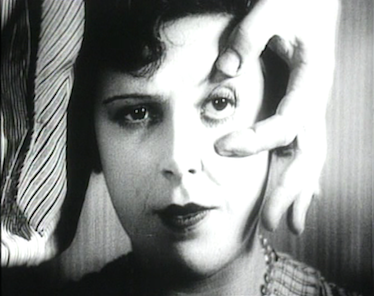 On March 15, I'll look at yet another experimental silent film, albeit a much shorter one: Luis Buñuel and Salvador Dali's surrealist short Un Chien Andalou (1929). Several versions of the film are available on YouTube, and it's only 15 minutes long, so you really have no excuse for not playing along.
On March 15, I'll look at yet another experimental silent film, albeit a much shorter one: Luis Buñuel and Salvador Dali's surrealist short Un Chien Andalou (1929). Several versions of the film are available on YouTube, and it's only 15 minutes long, so you really have no excuse for not playing along.
Then, on March 30, we will finally reach the glorious era of "talkies," and join the hunt for a serial killer in our old friend Fritz Lang's 1931 classic M.
Bibliography
As I confessed in my first post in this series, I am a terribly lazy and undisciplined researcher, but I do feel obliged to acknowledge some of the various pieces around the web that contributed to my tentative understanding of Man with a Movie Camera. I have credited specific facts, points, and quotes I stole in footnotes where appropriate, but here also is a list—in no particular order—of useful articles that got fed into the haphazard hopper of my brain while writing this post.
- "WE: Variant of a Manifesto," Dziga Vertov, Kinofot, 1922.
- "Man with a Movie Camera," review by Roger Ebert, Chicago Sun-Times, July 1, 2009
- "Saluting the Supreme Soviet Filmmaker, Dziga Vertov," J. Hoberman, Village Voice, April 13, 2011
- "Dziga Vertov: The Man with a Movie Camera and Other Restored Works," Noel Murray, The Dissolve, June 15, 2015
- "Man with a Movie Camera," review by Grant Tracey, Images
- "Is Man with a Movie Camera Brilliant, Boring, or Both?" Scott Beggs, Film School Rejects, October 9, 2012
- "Dziga Vertov," Jonathan Dawson, Senses of Cinema, March 2003
- "Dziga Vertov: The Man with the Movie Camera and Other Newly Restored Works," Jef Burnham, Film Monthly, June 2, 2015
- "Chelovek s Kinoapparatom," Neil Young, Floatation Suite, February 11, 2004
- "Man with a Movie Camera," A Shining Brainless Beacon
- "Dziga Vertov," Monoskop
- "Dziga Vertov," directors.sovietcinema.tumblr.com
- Wikipedia pages for Man with a Movie Camera, Dziga Vertov, Kino-Pravda, and Agitprop.
Notes
- Vertov, Draft copy of the article “Kak eto nachalos?” [How has it begun?], in Iz Nasledia 2, 2008, p 557. Trans. Andrey Smirnov. Quoted in “Dziga Vertov” on Monoskop.org.
- See Roger Ebert’s “Man with a Movie Camera” at http://www.rogerebert.com/reviews/great-movie-man-with-a-movie-camera-1929
- See Yuri Tzivian’s “Beyond Comparing: The Internal Dynamics of Intolerance,” at http://www.cinemetrics.lv/tsivian.php. Tsivian also argue persuasively for a more sophisticated examination of varying ASLs within a particular film, which—though it’s beyond my capacity here—would make for a fascinating study of Man with a Movie Camera.


